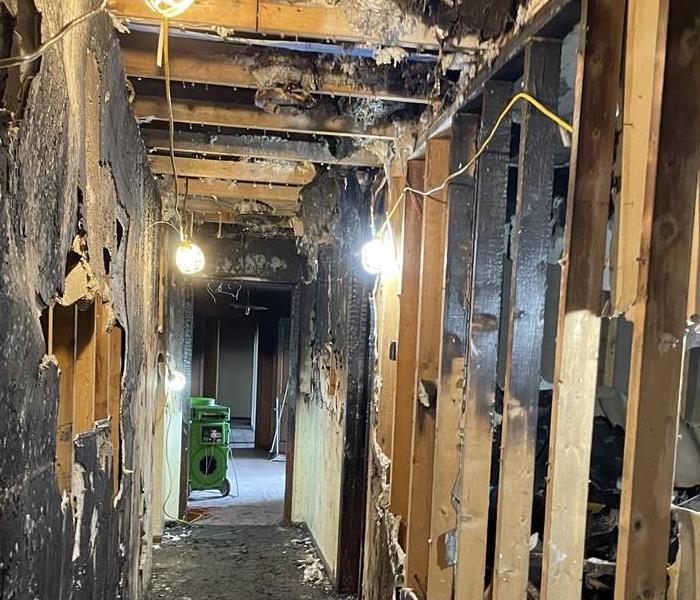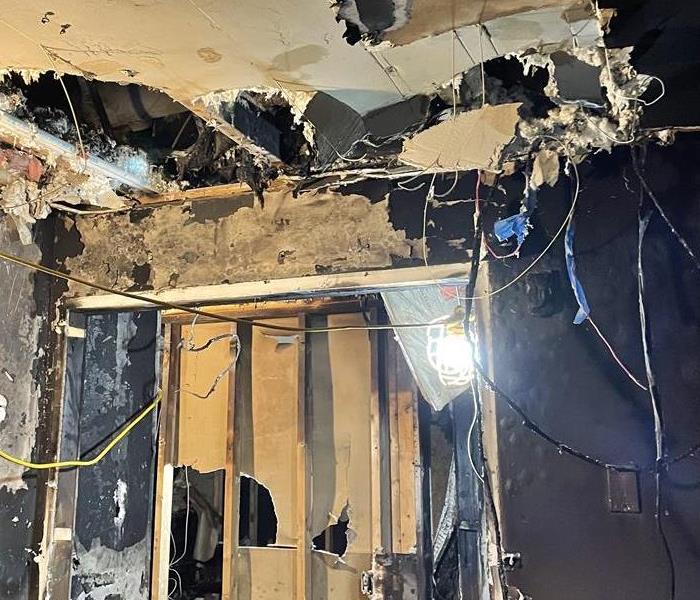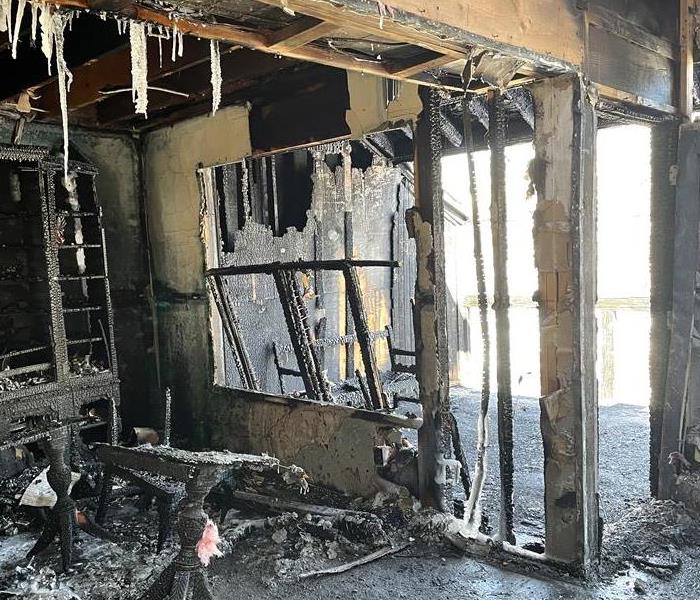US & Ohio Fire Facts
4/11/2023 (Permalink)
 We are "here to help" handle your home or business's fire damage restoration needs!
We are "here to help" handle your home or business's fire damage restoration needs!
The unpredictable nature of fires can lead to so much devastation and loss for your home or business.
According to the National Fire Protection Association, there are around 346,800 house fires per year causing on average 2,620 fatalities.
Understanding the facts when it comes to fires can help you to better prepare your family and employees in case of disaster.
General Fire Facts & Stats
- Cooking is the leading cause of house fires, followed by:
- Heating
- Electrical Systems & Equipment
- Candles
- Smoking
- In 2020, fire and lightning insurance claims had the highest average payout of $77,340.
- On average, across the US, a fire department responded to a fire every 23 seconds in 2021.
- In 2021, there were 1,353,500 fires reported, including residential and non-residential structures.
- In 2020, per 1,000 fires, the national average was 2 deaths and 8 injuries.
Ohio Fire Facts & Stats
- Ohio has the 7th most fatal home fires per capita in relation to the other 50 states, with Texas being the first.
- Smoking is the top cause of fire deaths in the state of Ohio, making up 20% of fatalities.
It's difficult and scary to imagine your home or business experiencing a fire. It can be hard to determine where to start when a disaster like this occurs.
If your home or business falls victim to a fire, SERVPRO of Parma/Seven Hills is "here to help." Our experienced technicians handle the care and restoration of your property and its contents. We handle the cleanup and the reconstruction, so you don't have to worry about juggling multiple companies.
If you find yourself in need of fire damage restoration, give us a call today!
Why You Should Call the Pros to Handle Your Fire Damage Restoration
12/6/2022 (Permalink)
 Our pros are there to handle your first damage restoration every step of the way.
Our pros are there to handle your first damage restoration every step of the way.
When the firefighters leave, it may seem like the danger has passed and the home is safe from further destruction, but without professionals to help clean the smoke damage, the building will never return to normal. While the principles behind fire restoration are fairly simple, the process requires a lot of experience and manpower to perform adequately, and this means that it shouldn’t be attempted by a homeowner on his or her own.
While fire is always the immediate danger, once it is gone, what it leaves behind will continue to affect the house. Ash and smoke, if left untreated, will cause extensive corrosion, etching and discoloration, not to mention lingering powerful odors. Professionals that clean fire and smoke damage can stop this before it becomes a major problem, assuming they are contacted soon enough. There are many companies out there that advertise their ability to restore areas affected by fire, but only those with proper training and certification should be considered. The Institute of Inspection Cleaning and Restoration Certification (IICRC) is the main oversight agency in this industry. The IICRC requires its registrants to take extensive coursework before earning their certification. SERVPRO of Parma/Seven Hills is IICRC certified, with our technicians constantly earning new certifications.
These professionals can clean smoke damage and restore items affected by a fire, but they must be brought to the site as soon as possible to halt the ongoing issues that ash residue can cause. The first thing that ash does to the home is discolor most surfaces. Anything that is made of plastic or was close to the fire will start discoloring within minutes, and within several hours, fiberglass and finishes on appliances will begin to yellow. Metals may also tarnish. After a few days pass, the ash will cause walls to discolor permanently, along with clothing and upholstery. Wood and vinyl will need to be refinished or replaced, and metal will start corroding.
If a professional isn’t hired to clean smoke and fire damage, the costs for restoration will skyrocket after a few weeks. Metals may need to be replaced, carpet will permanently discolor and glass may be severely etched, which will necessitate replacement. It will also become apparent that the odors caused by the disaster may still be present and intense enough to be distracting. Because ash is acidic, the longer it takes to hire experts, the more destruction it will cause.
The first thing a trained, certified, professional company will do when on site is to identify all affected materials and the source of any odors. The only way to properly clean smoke and fire damage is to be extremely thorough. Ash residue is easily disturbed and can spread through the building with ease, causing nearly everything to need restoration. The experts will identify what can and cannot be salvaged, and will remove any built-up ash residue that is coating surfaces. Over time, ash builds up in layers, and may eventually form into a lacquer-like consistency. Once this is done, the restorers will locate the source of the odor, and treat it with specialized detergents that are formulated for neutralizing this kind of odor. Once materials are treated, they may be sealed off to prevent any further odor from permeating the air in the future.
This entire process is very detailed, and hiring a professional that can be trusted to do the job right is imperative. That's why you should call SERVPRO of Parma/Seven Hills to handle your fire damage restoration needs! We have the equipment and experience to help quickly and efficiently clean and restore your home. We do what we do best, so you can get back to doing what you do best!
Preventing Dryer Fires in Your Parma/Seven Hills Home
11/22/2022 (Permalink)
 SERVPRO of Parma/Seven Hills has the manpower and equipment to handle any size fire damage in your home!
SERVPRO of Parma/Seven Hills has the manpower and equipment to handle any size fire damage in your home!
How to Prevent Dryer Fires
Dryers and washing machines cause around 15,970 fires each year, with dryers causing 92% of them. Dryer fires cause injuries for hundreds of people each year, and on average cause around $238 million in property damage.
Given these numbers—and the fact that more dryer fires occur in the fall and winter—SERVPRO of Parma/Seven Hills wants to be sure that you know how to prevent dryer fires in your home!
Clean Your Lint Filter
Not once a month, or even once a week, lint should be removed from the lint screen with every load of laundry you do. It doesn’t matter if you take this step before or after running a load, but remove any lint from the screen at some point during each use. Not only does this prevent a fire, but it also helps your clothes dry faster as well.
Replace Accordion-Style Ducts
Generally, dryers are equipped with a 4-inch vent in the back, which homeowners or installers connect to an exterior vent with a duct. But not all ducts are created equal.
If you see a plastic or foil accordion-style duct connecting your appliance to the vent, it's a good idea to replace it.
Plastic or foil ducts can sag, which may cause lint to build up in low points. The ridges that these types of ducts have also work as hiding places for lint buildup. It is recommended to use a metal duct, whether it’s flexible or rigid, since it won’t sag, and lint is less likely to accumulate. Use the shortest length possible, and refer to the manual’s instructions.
Inspect Vent and Exhaust Duct Periodically
If you notice that your dryer takes longer to dry laundry than it used to, it’s a clue that there may be a blockage. Another clue: When you’re drying a load, head outside, and take a look at the dryer vent, if you have access to it. Do you see or feel exhaust air? If not, the vent or exhaust duct may be blocked with lint.
The Consumer Product Safety Commission recommends disconnecting the duct from the dryer, cleaning it out, and reconnecting the duct to the dryer and outside vent. While you’re at it, clean behind the dryer and underneath it—lint builds up there, too. In winter, be sure that snow isn’t covering the outdoor vent.
Take Care When Washing Stained Items
Clothes stained with flammable chemicals or substances, such as gas, cooking oil, cleaning agents, or paint thinners, need special care. The CPSC recommends washing the clothing more than once to minimize the volatile chemicals, then hanging to dry. If you must use a dryer, use the lowest heat setting and a drying cycle that concludes with a cool-down period.
In the event that a fire does start, keep the dryer door closed in order to stifle the flames.
If you experience a dryer fire and are in need of fire damage restoration, be sure to call SERVPRO of Parma/Seven Hills!

 24/7 Emergency Service
24/7 Emergency Service


